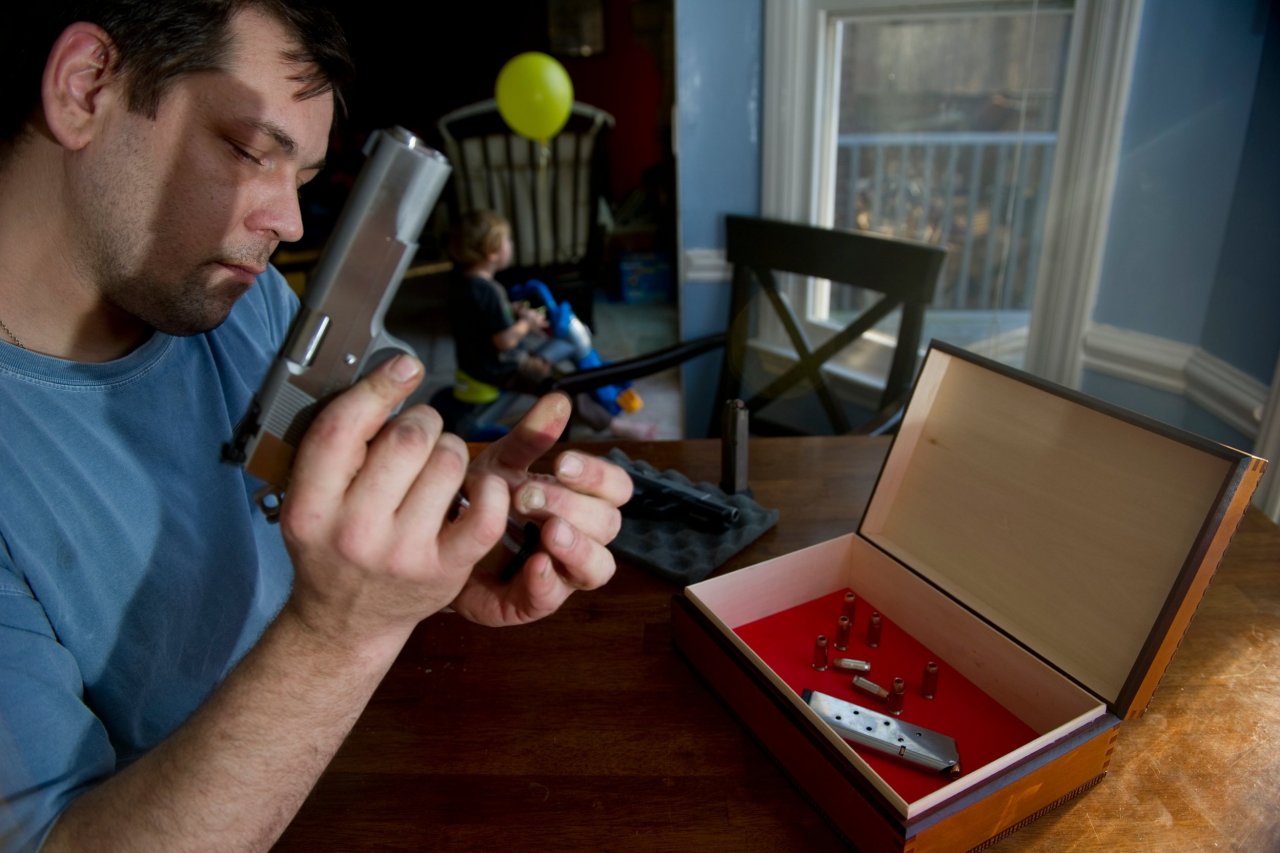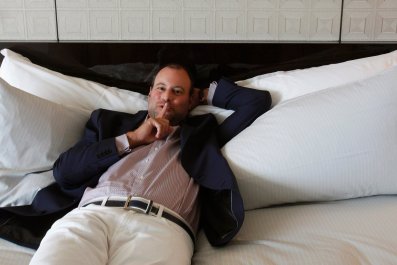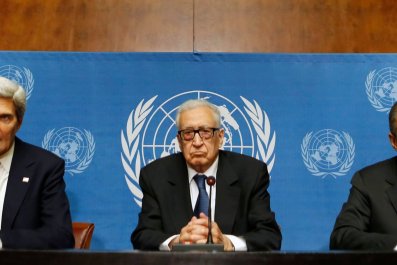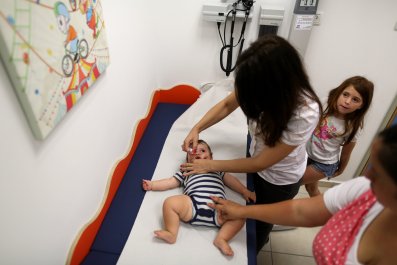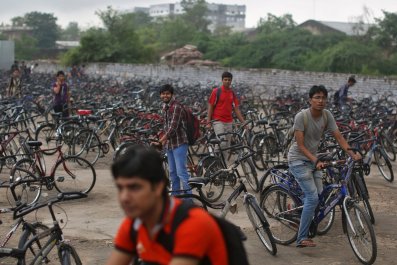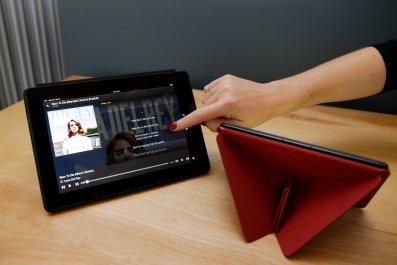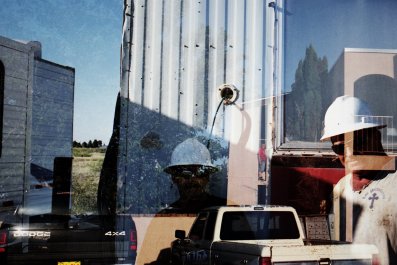The weapon he was carrying, an AK-74 assault rifle, measures three feet long, with a barrel of about 16 inches, and is capable of firing several dozen rounds per minute. Brian McCauley says he never meant to scare anyone. The state of Texas disagrees, and his upcoming trial has become a focal point in a dangerous new battle in the national debate over gun laws.
By the time McCauley walked into a San Antonio Starbucks in August, tensions had been building for years. The chain's corporate policy was to defer to local gun ordinances, many of which allow the open carrying of weapons, and gun owners from Virginia to California had been visiting the coffee shops with handguns worn outside their pants, as the songwriter Townes Van Zandt once put it, "for all the honest world to feel." In response, a gun-control group, Moms Demand Action for Gun Sense in America, started promoting a national boycott called "Skip Starbucks Saturday."
Police officers arrested McCauley outside that Starbucks, charging him with disorderly conduct, which under the Texas penal code, covers 11 categories of behavior, including that of a person who "displays a firearm or other deadly weapon in a public place in a manner calculated to alarm."
Those last three words – calculated to alarm – have inflamed passions on both sides. Leaders of the open carry movement, once regarded as fringe-y by more traditional gun rights organizations, are rapidly signing up new members and staging bolder public confrontations. Gun-control advocates, who failed to win legislative change following the massacre at Connecticut's Sandy Hook Elementary School, are using the image of semi-automatic weapons in public places to reinvigorate their supporters.
As McCauley awaits his day in court, both sides are escalating their tactics. In September, two men wearing AR-15s walked through a farmer's market in downtown Appleton, Wisconsin. Gun rights advocates scheduled a major rally at the Alamo on October 19, to coincide with a national event called Guns Next Door, where gun owners are encouraged to "for one hour stand or sit in your front yard armed." In response, Moms Demand Action is advising supporters who encounter someone carrying a semi-automatic rifle to "call 911 immediately."
By moving from the stalemated legislative arena to the streets, both sides seek to redefine the role of firearms in modern society. President Obama, in his remarks at a memorial service for victims of the mass shooting at the Washington Navy Yard last month, inadvertently encapsulated the goals of gun control and gun rights groups alike: "Change will come the only way it ever has come," he said, "and that's from the American people."
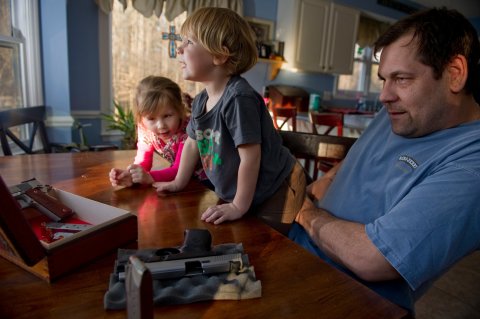
Greasy Cardsharps and Baristas
There was a time in this country, prior to mass urbanization, when civility demanded the open holstering of weapons. "You had to be some sort of greasy cardsharp to go around with a derringer concealed," says Brannon Denning, a constitutional law professor at Samford University in Alabama. "Now, it's flipped." For the past two decades, state governments have expanded the right to carry licensed handguns for self-defense, but only in concealment. As a side effect of that uneasy compromise, many Americans tend to equate the sight of a gun with malicious intent. And many gun owners take offense at the stereotype.
But there are guns, and then there are guns.
Less than a year ago, a madman with a Bushmaster .223 semi-automatic rifle killed 20 children, six educators and his own mother in a massacre culminating at an elementary school in Newtown, Conn. When the initial reports flashed across her iPhone, Shannon Watts, a communications executive who had left her corporate post to stay home with her five children in the suburbs of Indianapolis, was out running errands. She went home, sat on her bed and watched the rest of the horror play out on TV. Though she had never been politically active, she says, "I did know how to start a Facebook page. And I was so angry and so beside myself the day Sandy Hook happened, I had to do it."
Watts first called her group One Million Moms for Gun Control, but "gun control," she soon realized, had become a "taboo phrase." She renamed her group Moms Demand Action For Gun Sense in America, and quickly got some traction. "[Moms] are the de facto caregivers," Watts says. "What more emotional voice to go up against the emotion of fear that the gun lobby creates?"
Recruiting more than 100,000 members, with chapters in all 50 states, she focused on lobbying Congress. Majority Leader Harry Reid invited her to talk about the Senate vote on background checks. But when that federal reform proposal fell apart, Watts changed tactics. Modeling her new campaign on Mothers Against Drunk Driving, she set out to make the sight of a gun "as distasteful as smoking and drunk driving."
In May, Watts started urging her members to patronize certain stores – including Peet's Coffee & Tea, IKEA and Dick's Sporting Goods – and to boycott others – Starbucks, Walmart, Cabela's, Wyndham, and National Car Rental – based on their gun policies. Gun-rights groups responded with "Starbucks Appreciation Days."
"I think," Watts says, "it's not headed to a good place."

"Walking on a Busy Highway With a Large Gun"
The leader of the open carry movement in Texas, Army Master Sgt. C.J. Grisham, 39, lives on a bumpy old country road on the outskirts of Temple, not far from Fort Hood. The sign in his front window says: "Trespassers will be shot. Survivors will be shot again," but the living room has a woman's touch, with puffy red sofas, a stack of board games and a tastefully appointed mantel. He has three children, two girls and a boy ranging in age from 11 to 17, who have enjoyed having his help on homework questions since his return from Afghanistan in March 2012.
On a Saturday last March, Grisham went on a 10-mile hike with his son, Christopher. Wary of coyotes and feral hogs, he slung a Blackjack AR-15 assault rifle over his shoulder and holstered a licensed Kimber Ultra Carry .45-caliber pistol at his waist. "I don't own a bolt-action rifle or a deer rifle," he says. "I've been in the military my entire adult life. An AR-15 is the weapon I've been trained on."
Shortly after noon, the police received a call from a woman who "was alarmed seeing this individual walking on a busy highway with a large gun." In a report, officers noted that they stopped Grisham within a couple miles of an airport entrance, an elementary school and a hospital. On this much, Grisham and the police agree: He did not hand over his weapon eagerly. Asked why he was carrying an assault rifle, he told the officer, "Because I can."
And when the officer reached for his rifle, Grisham says, "I had just gotten back from Afghanistan. My reaction was to grab it and say, 'Hey man, don't disarm me.' "
Grisham was charged with resisting a lawful search. He plans to contest the charge. With his story as inspiration, some members of the open carry movement started reaching for their own assault rifles.
Trespassers will be shot. Survivors will be shot again.
"Ready to Fire"
Brian McCauley does not usually hang out at Starbucks. He feels a lot more comfortable at Top Brass, a military surplus store stocked with knives, tactical gear and camouflage apparel.
As a Boy Scout, he learned to shoot a .22-caliber bolt-action rifle for a merit badge, and he describes himself as a staunch defender of the Second Amendment. He believes American citizens may one day need to take up firearms against a "tyrannical" government.
McCauley says he was shopping at Top Brass in early August when the conversation turned to the Starbucks boycott.
"I just feel like it's time to push back," he recalls thinking.
Using his iPhone, McCauley clicked a pin on the map, called the nearest Starbucks and asked whether the manager followed the corporate policy deferring to local weapons laws. (Texas restricts the open display of handguns, but it makes no direct provision restricting rifles.) Told that a lawfully armed visit would meet no objection, he placed another call to the nearest police station, seeking to notify the authorities of his intentions. By his account, efforts to navigate the station's automated phone menu proved unsuccessful.
Joined by Andrew Fernandez, 26, who was carrying an AR-15, McCauley drove to Starbucks with his AK-74 in his Mustang convertible. A third friend, a former soldier named Chris Davis, 36, drove to the Starbucks in his truck, carrying an AK-47. He also brought a JVC high-definition camcorder.
There was one problem with McCauley's orchestrated confrontation: The Starbucks he went to was not the Starbucks he had called earlier. Having received no warning phone call, an employee asked the men not to film inside the store. So they took their guns outside, sat at a table under a green umbrella and sipped their drinks through straws until the police arrived.
"The manager at the location along with citizens that were leaving the location expressed concern as the men had the automatic rifles on their laps and in hand," Officer David Rodriguez wrote in the police report. "I advised all three men that unlike other demonstrators who often 'shoulder' their weapon or sling the weapon across their back, they had their weapons in hand with rounds in the magazine. The weapons that each man displayed held rounds in the magazine and had open slides that just needed to be closed to make each weapon ready to fire."
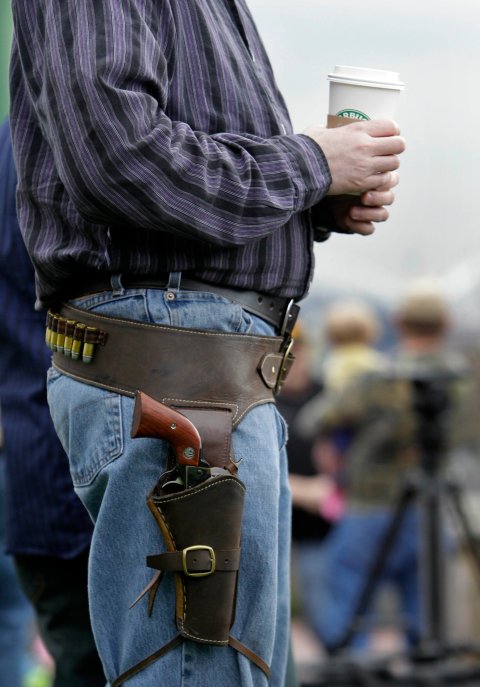
Clean up, Aisle Three. Shot Fired at Staples
It is not often that the chief executive of a restaurant chain addresses a letter to "Dear Fellow Americans." But last month, under intense pressure, Howard Schultz of Starbucks found himself using the common salutation of stump speeches as he asked customers to leave their guns at home.
For corporate brands, setting a gun policy may prove more complicated than getting on the right side of issues like civil rights or environmental stewardship. "Basically, the gun issue is likely to be a no-win situation for most businesses," says Barbara Gainey, a crisis management expert at Kennesaw State University in Georgia.
But for Moms Demand Action, the Starbucks announcement marked the first "huge win" in their rapidly expanding campaign. Watts hopes to elicit a policy statement from Staples, where a woman accidentally shot herself in the hand at a store in North Carolina in August.
She knows that would be another victory but only a small one. "I wish I could tell you there is an ultimate goal," she says.
For now, though, she is turning her attention to the conflict at hand. The men carrying assault rifles, she tells her supporters, "can be arrested if people feel frightened."
Asked why he was carrying an assault rifle, Grisham told the officer, 'Because I can.'
The Calculation to Alarm
Gun rights advocates expect McCauley and his friends to win their case when they go before a judge. "When the charges get brought to court, they lose," says Joseph E. Olson, a NRA board member and a law professor at Hamline University in St. Paul, Minn. "Disorderly conduct has to convince a reasonable person – not a political activist – that a threat was being directed at them."
But after the battle of Starbucks, leaders of the open carry movement are taking their campaign to a new arena. In promotional materials for "Come and Take It San Antonio – Line in the Sand," they promise to send "a strong message to [San Antonio Police Chief William] McManus that we have a right to bear arms and it will NOT be infringed."
Already, this aggressive new posture has drawn some backlash. Officials from the National Rifle Association did not respond to requests for comment, but "you don't do political activism just for your own emotional expression," says Dave Kopel, a libertarian-minded gun policy analyst at the Cato Institute. "You do political activism to advance your cause. And there's a feeling some of the open carry people have gone too far."
To Grisham, who now leads a group called Open Carry Texas, confronting the police and Moms Demand Action ("Thugs with Jugs," he calls them) serves a long-term strategy. "I think it's more important to change the societal norm and the societal acceptance, to acclimate society to seeing the safe carrying of firearms," he says. "Once you do that, the rest will come. The laws will come."



